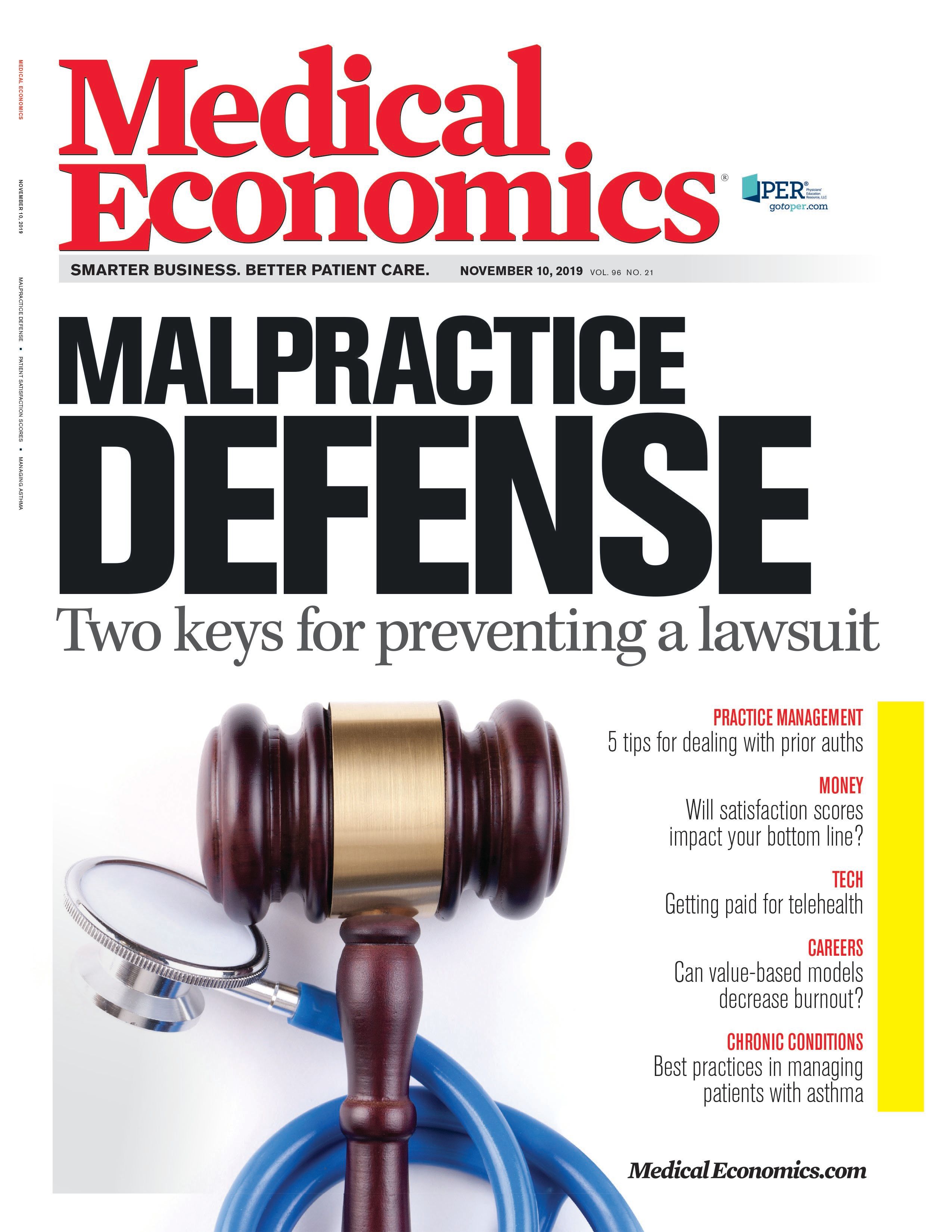Publication
Article
Medical Economics Journal
How to avoid malpractice suits
Author(s):
Focus on trust and communication

Doctors frequently worry about getting sued for malpractice, and with good reason. Although the number of lawsuits has been declining in recent years, there were still more than 11,500 filed in 2018, according to data compiled by LeverageRX, an online lending and insurance broker for healthcare. Meanwhile, malpractice payouts rose nearly 3 percent compared to 2017 to about $4 billion.
In spite of those daunting numbers, physicians needn’t think of malpractice suits as inevitable. Understanding the reasons for lawsuits can help doctors minimize the chances of being sued and improve the odds of a favorable outcome if they are.
The main point to remember, experts say, is that most malpractice suits are not really about money. “Any plaintiff’s lawyer will tell you that no patient walks into their office screaming, ‘I want a million dollars,’” says Richard Boothman, JD, a risk management consultant in Ann Arbor, Mich., and a former trial attorney and chief risk officer for the University of Michigan Health System.
Instead, Boothman says, lawsuits usually are the result of injured patients or their families wanting to find out what went wrong, who was responsible for it, and to see that it doesn’t happen to others.
With that in mind, what can doctors-particularly those in primary care-do to reduce their legal exposure?
Strive for trusting, open relationships
A good place to start, according to those with experience in malpractice cases, is to establish trusting and open relationships with patients. That, in turn, requires two things: good communication skills, and lots of face time with patients.
Fred Cummings, JD, a malpractice attorney with Dickinson Wright in Phoenix, Ariz., says that a significant motivator among many of his clients is the feeling that their doctor didn’t spend enough time with them, or wasn’t really listening when they described their health problems.
Moreover, without a trusting relationship patients are less likely to reveal personal information, such as drug use or sexual activity, that their doctor needs to properly diagnose and treat them, says Darrell Ranum, JD, vice president of patient safety and risk management for The Doctors Company, a medical malpractice insurer. Ranum adds that patients who trust their doctor are more likely to adhere to a medication regimen and obtain recommended follow-up tests and procedures.
Cummings acknowledges the difficulties most primary care doctors face in spending as much time with patients as they-or patients-would like. That challenge makes it vital to find ways of maximizing the limited time they do have, such as by using scribes to record and enter data for patient visits, thereby allowing the doctor to focus entirely on the patient.
Good communication is key
In addition to spending time with patients, Cummings and others emphasize the importance of effective communications-oral and written-for heading off malpractice suits, and bolstering a doctor’s case if they are sued. “It’s not enough just to be a brilliant diagnostician, you’ve got to be able to communicate your diagnosis to the patient and have that patient feel confident that you know what you’re doing,” Cummings notes.
His observation is supported by data from The Doctors Company. “We find that one of the key factors [behind malpractice suits], appearing in 21 percent of our claims, is a lack of communication between the patient or their family and the physician,” says Ranum.
Effective written communication covers areas such as explanations for referrals, interpreting lab results, and clear and contemporaneous documentation of patient visits.
“In my experience, the number one reason for a successful malpractice suit lies in the charting,” Cummings says. “Either something that wasn’t charted that should have been or because not enough of the reasoning behind treatment decisions was recorded in the chart. So the more accurate your charting, the better.”
Document patient visits ASAP
Boothman agrees, and emphasizes the importance for malpractice defense of documenting a patient visit as soon as possible. “When my clients were sued, one of the first things that I needed to do was to recreate the circumstances,” he explains. “I can’t do that if they don’t have a note with enough detail so that years later, if a lawsuit does arise, we can recreate what happened at that visit.”
Accurately diagnosing a patient can be especially challenging for primary care doctors because of the wide range of medical problems they encounter, Ranum says. The largest category of patient allegations in The Doctors Company study-39 percent-were diagnosis-related. That means physicians have to be careful to follow a differential diagnosis process, and document that they have done so.
“If the physician’s diagnosis is questioned at some point in the future, and the documentation reflects a thoughtful and systemic approach to arriving at a diagnosis, then the doctor is more likely to be seen as being reasonable in their approach rather than negligent for missing a diagnosis,” Ranum says.
The role of practice culture
Boothman notes that a practice or organization’s culture plays an important role in ensuring patient safety and thus the frequency of malpractice suits. “In workplaces where the physician is regarded as captain of the ship and the people around him don’t feel empowered to raise concerns about a patient’s treatment, that culture can create a higher medical malpractice risk,” he says.
Conversely, he adds, when physicians treat other members of the care team as equals and welcome their questions and suggestions, “Then you know the patient is going to get the benefit of many sets of eyes and lots of brains thinking about that patient, and it creates a much safer situation for everyone concerned.”
Another essential aspect of practice culture for minimizing malpractice risk is creating, and adhering to, protocols for ensuring patient safety and maintaining good communication, such as training receptionists and other staff members to know when they can respond to a patient’s question and when to refer it to a doctor.
Similarly, Ranum says, primary care practices need systems for confirming that patients follow through on referrals and recommended procedures. He cites the example of a patient referred for a chest x-ray for pneumonia, the radiologist identifies a possibly cancerous lung nodule, but forgets to send the results to the primary care doctor.
“So the physician never follows up on that lung nodule and a few years later the patient has worsening symptoms and is identified with lung cancer,” he says.
Don’t be afraid to refer
A further area where primary care doctors can get into legal trouble is failing to make referrals when they are warranted. “Sometimes primary care docs can get in over their head if they don’t seek assistance,” Ranum says, such as when a patient repeatedly sees their primary care physician for the same symptoms.
“If all the standard remedies are not working, then it’s time to move that patient on to a specialist who can maybe identify the real cause of the problem,” he advises.
But from a legal standpoint, merely referring the patient isn’t enough. Primary care doctors also have to document that they made the referral and followed up with the patient. “I will tell you that unless confronted with some documentation that they were given a referral slip, every patient [in a malpractice suit] will say they don’t remember getting a referral,” Cummings says.
Moreover, he adds, under some circumstances primary care doctors who continue treating a patient for the problem for which they referred the patient to a specialist can be held to the medical standard of the specialist in a malpractice suit, even if the patient doesn’t see the specialist.
“So refer often, but if the patient doesn’t go, make sure you document that,” Cummings advises. “And at some point you need to send the patient something in writing about their noncompliance and what it might mean for them medically.”
In the end, Boothman says, the best way for doctors to avoid getting sued for malpractice is by putting the patient at the center of everything they do. And while that may sound obvious, it is often difficult given the many pressures, from seeing additional patients to improving quality ratings, that can pull them away from patient care. Nevertheless, he says: “Doctors always need to remind themselves what a remarkable statement of trust it is that patients put their well-being in the physician’s hands and do the things doctors do to patients. It’s a staggering privilege.”
“What typically happens is that there’s a failure to input or access information that is vital to a patient’s health,” he explains. “Therefore, that information is not communicated to another medical care provider who is also involved with the patient’s care and something bad happens.”
The Doctors Company study found system errors like fragmented EHRs (i.e., a system where key sections of a patient’s record aren’t located together), technology failures, and electronic data routing issues did contribute to some claims. But Zaslow says true technology-related cases are uncommon.
“Unfortunately, because these systems aren’t as user-friendly as they often claim to be, and because medical providers have a lot of responsibility keeping track of a lot of things for a lot of different patients, important information just isn’t being inputted in the right way,” he says.






